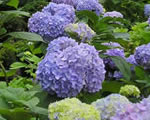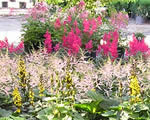
5155
NW 57th Ave
Johnston, Iowa
Click for Directions
Store
Hours
Monday
- Friday
8:00am - 5:00pm
Saturday
8:00am - 4:00pm
|
Phytopthora
Root Rot in Rhododendron
Rhododendrons are a popular spring flowering shrub found in many Iowa landscapes. Unfortunately, they are susceptible to phytopthora root rot if not planted in the right location. Phytopthora is a water mold fungus in the soil. The most common types are: · Phytopthora
cinnamomi The fungus attacks the roots of susceptible roots causing them to rot and die. However, there are measures one can take to decrease the possibility of getting the disease. Environmental conditions need to be considered seriously. Environmental Factors That Influence Disease Rhododendrons prefer a well-drained soil with high moisture holding capacity. But if planted in site with high soil moisture and soil temperatures, slow decline or infection by phytopthora will eventually occur. However, there are ways to control the disease. Control Water: Chemical:
|
© Miller Nursery Inc. 2008


